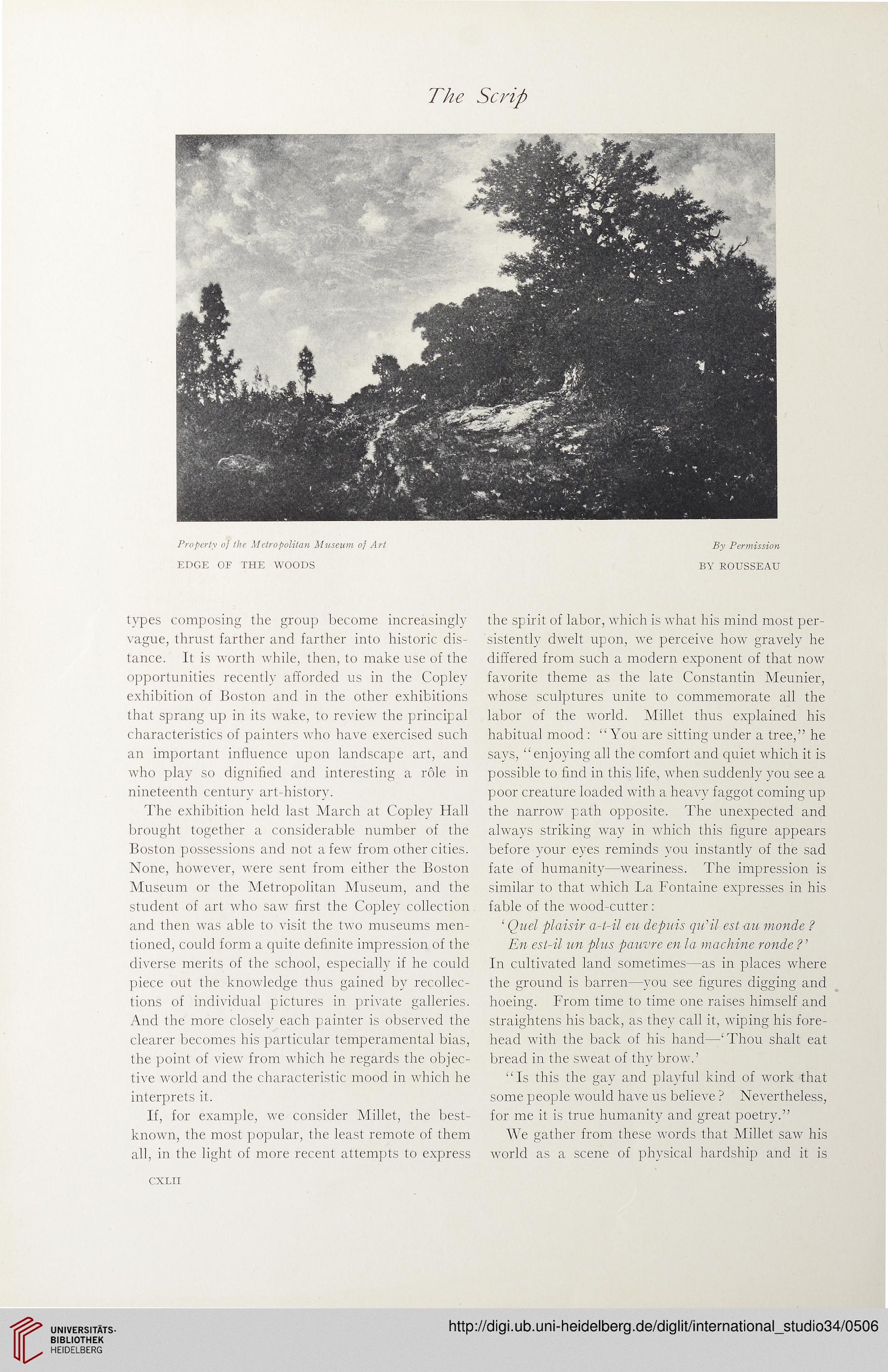The Scrip
Property oj the Metropolitan Museum oj Art By Permission
EDGE OE THE WOODS BY ROUSSEAU
types composing the group become increasingly
vague, thrust farther and farther into historic dis-
tance. It is worth while, then, to make use of the
opportunities recently afforded us in the Copley
exhibition of Boston and in the other exhibitions
that sprang up in its wake, to review the principal
characteristics of painters who have exercised such
an important influence upon landscape art, and
who play so dignified and interesting a role in
nineteenth century art-history.
The exhibition held last March at Copley Hall
brought together a considerable number of the
Boston possessions and not a few from other cities.
None, however, were sent from either the Boston
Museum or the Metropolitan Museum, and the
student of art who saw first the Copley collection.
and then was able to visit the two museums men-
tioned, could form a quite definite impression of the
diverse merits of the school, especially if he could
piece out the knowledge thus gained by recollec-
tions of individual pictures in private galleries.
And the more closely each painter is observed the
clearer becomes his particular temperamental bias,
the point of view from which he regards the objec-
tive world and the characteristic mood in which he
interprets it.
If, for example, we consider Millet, the best-
known, the most popular, the least remote of them
all, in the light of more recent attempts to express
the spirit of labor, which is what his mind most per-
sistently dwelt upon, we perceive how gravely he
differed from such a modern exponent of that now
favorite theme as the late Constantin Meunier,
whose sculptures unite to commemorate all the
labor of the world. Millet thus explained his
habitual mood : “You are sitting under a tree,” he
says, “enjoying all the comfort and quiet which it is
possible to find in this life, when suddenly you see a
poor creature loaded with a heavy faggot coming up
the narrow path opposite. The unexpected and
always striking way in which this figure appears
before your eyes reminds you instantly of the sad
fate of humanity—weariness. The impression is
similar to that which La Fontaine expresses in his
fable of the wood-cutter :
‘ Quel plaisir a-t-il eu depuis qu’il est au monde ?
En est-il un plus pauvre en la machine ronde ? ’
In cultivated land sometimes—as in places where
the ground is barren—you see figures digging and
hoeing. From time to time one raises himself and
straightens his back, as they call it, wiping his fore-
head with the back of his hand—‘Thou shalt eat
bread in the sweat of thy brow.’
“Is this the gay and playful kind of work that
some people would have us believe ? Nevertheless,
for me it is true humanity and great poetry.”
We gather from these words that Millet saw his
world as a scene of physical hardship and it is
CXLII
Property oj the Metropolitan Museum oj Art By Permission
EDGE OE THE WOODS BY ROUSSEAU
types composing the group become increasingly
vague, thrust farther and farther into historic dis-
tance. It is worth while, then, to make use of the
opportunities recently afforded us in the Copley
exhibition of Boston and in the other exhibitions
that sprang up in its wake, to review the principal
characteristics of painters who have exercised such
an important influence upon landscape art, and
who play so dignified and interesting a role in
nineteenth century art-history.
The exhibition held last March at Copley Hall
brought together a considerable number of the
Boston possessions and not a few from other cities.
None, however, were sent from either the Boston
Museum or the Metropolitan Museum, and the
student of art who saw first the Copley collection.
and then was able to visit the two museums men-
tioned, could form a quite definite impression of the
diverse merits of the school, especially if he could
piece out the knowledge thus gained by recollec-
tions of individual pictures in private galleries.
And the more closely each painter is observed the
clearer becomes his particular temperamental bias,
the point of view from which he regards the objec-
tive world and the characteristic mood in which he
interprets it.
If, for example, we consider Millet, the best-
known, the most popular, the least remote of them
all, in the light of more recent attempts to express
the spirit of labor, which is what his mind most per-
sistently dwelt upon, we perceive how gravely he
differed from such a modern exponent of that now
favorite theme as the late Constantin Meunier,
whose sculptures unite to commemorate all the
labor of the world. Millet thus explained his
habitual mood : “You are sitting under a tree,” he
says, “enjoying all the comfort and quiet which it is
possible to find in this life, when suddenly you see a
poor creature loaded with a heavy faggot coming up
the narrow path opposite. The unexpected and
always striking way in which this figure appears
before your eyes reminds you instantly of the sad
fate of humanity—weariness. The impression is
similar to that which La Fontaine expresses in his
fable of the wood-cutter :
‘ Quel plaisir a-t-il eu depuis qu’il est au monde ?
En est-il un plus pauvre en la machine ronde ? ’
In cultivated land sometimes—as in places where
the ground is barren—you see figures digging and
hoeing. From time to time one raises himself and
straightens his back, as they call it, wiping his fore-
head with the back of his hand—‘Thou shalt eat
bread in the sweat of thy brow.’
“Is this the gay and playful kind of work that
some people would have us believe ? Nevertheless,
for me it is true humanity and great poetry.”
We gather from these words that Millet saw his
world as a scene of physical hardship and it is
CXLII




